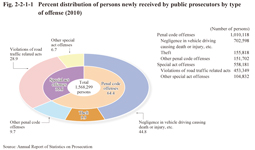Chapter 2 Prosecution
Section 1 Reception of Suspected Cases
The total number of persons newly received by public prosecutors (including juvenile cases) was 1,568,299 in 2010, down 71,316 (4.3%) from the previous year. The total number of persons newly received for penal code offenses was increasing from 1998 but then turned to a decreasing trend in 2005, and was 1,010,118 in 2010 (down 2.5% from the previous year). The number of persons newly received for special act offenses was on a decreasing trend from 2000, and was 558,181 (down 7.6% (id.)) in 2010 (Source: Annual Report of Statistics on Prosecution).
Fig. 2-2-1-1 shows the percent distribution of persons newly received by public prosecutors by type of offense in 2010. Of persons received for penal code offenses those received for negligence in vehicle driving causing death or injury, etc. accounted for the majority at 702,598 and the number of those received for non-traffic penal code offenses 307,520. Theft accounted for the largest number within non-traffic penal code offenses at 155,818, followed by embezzlement (including embezzlement of lost property) at 29,505, injury at 26,546, and fraud at 17,471. Of persons received for special act offenses the number of those received for violations of road traffic related acts was 453,349 and for special act offenses excluding violations of road traffic related acts 104,832 (See Appendix 2-1).
Fig. 2-2-1-1 Percent distribution of persons newly received by public prosecutors by type of offense (2010)
Table 2-2-1-2 shows the number of persons newly received by public prosecutors for non-traffic penal code offenses and special act offenses excluding violations of road traffic related acts by the type of their reception in 2010. Criminal cases include those referred or transferred by general judicial police officers, as well as special judicial police officers, including coast guard officers and narcotics agents, etc., and also those public prosecutors found by their own detection or receiving complaints/accusations.
Table 2-2-1-2 Percent distribution of persons newly received by public prosecutors by type of reception (2010)

